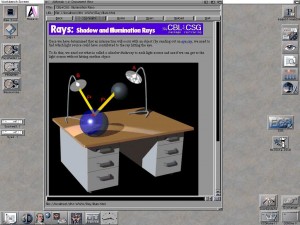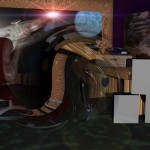CyberStorm 060 + Cybervision 64 (CU Amiga August 1995)
Vista pro 3 takes 66 seconds to render a nice scene of the grand canyon; the 030/882 combo takes 666 seconds. This was at the highest quality that Vista would render to, too, although the size of image wasn’t large. However, a speedup of a factor of 10 is nothing to be sniffed at whatever the situation!
 Mosaic is getting more and more use on the Amiga as it is the tool which is used to access the World Wide Web (a collection of sites carrying information on the Internet). GIFs need to be decoded which takes time; this time is expensive as your computer will also be connected to the phone whilst you’re waiting for the decoding to happen. The 030 takes 16 seconds to decode a page. 2 seconds sees the same task finished on the 060. I want one!
Mosaic is getting more and more use on the Amiga as it is the tool which is used to access the World Wide Web (a collection of sites carrying information on the Internet). GIFs need to be decoded which takes time; this time is expensive as your computer will also be connected to the phone whilst you’re waiting for the decoding to happen. The 030 takes 16 seconds to decode a page. 2 seconds sees the same task finished on the 060. I want one!
ADPro is another power tool that gets its fair share of commercial use. One of the most computing intensive functions that I use within it is the “Twirl” function, which distorts an image as if it had been pinched and then twisted. The reference 030/882 combination takes a mammoth 162 seconds to twirl an 800×600 24 bit image whereas the 060 takes under nine!
Finally on the test front, Lightwave 3.5 is undoubtably the most commercially used Amiga application. The same scene that was used in the 3D spectacular article a few months back was re-rendered in the highest possible quality mode. The 060 took 33 minutes compared to 4 hours 14 minutes on the 030/882 running at 25MHz. I must confess to being slightly disappointed at this, but on reflection I reckon it still wasn’t bad. I get the feeling that the lightwave render module isn’t as efficient as it should be and I hope for faster from Lightwave 4. This isn’t a problem of the accelerator though. Compared to 3D Studio on a Pentium, it could be considered as slow but one reason for this is that a Pentium normally has 256Kb of secondary level cache which really affects the performance of rendering. The images produced by 3D Studio aren’t quite the same as Lightwave’s either.
The expansion possibilities ought to be mentioned. There’s two free slots on the CyberStorm. Already available is a SCSI interface, along with a SCSI interface that incorporates Ethernet and high speed serial ports. Phase 5 are investigating production of a secondary cache: maybe this would help with rendering? Upgrading to a 66MHz chip is a case of plugging one in and changing an oscillator. On the review version, this oscillator was soldered but it may be pluggable on later versions.
